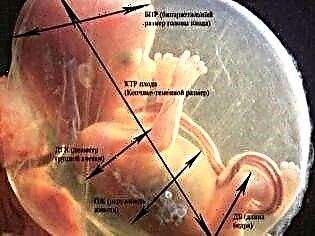
Immediately after the pleasant news of the onset of pregnancy from a doctor or according to the results of a home test, the second most important and urgent question is the question of when the birth should happen. The estimated day of the onset of labor is called short and capaciously - PDR. The estimated day of birth can be calculated independently, you can use a calculator-counter, or you can trust the calculations of an obstetrician-gynecologist. Whether the date of conception will help in calculating, this article will tell.

General information about the DA
PDR is an abbreviation used in obstetrics and gynecology to indicate the expected date of birth. Experts determine this value so that it would be easier for the doctor and the expectant mother herself to navigate the course of pregnancy, to prepare for an important day - the child's birthday. Do not think that the estimated date of birth and the baby's birthday must necessarily coincide.
In practice, this does not happen often - only every twentieth baby is born on a day defined as PDD. All other babies “choose” other days for themselves, which can fall both in the period before PDD, and in a certain period after this day.
No doctor in the world can tell you exactly when labor will begin. This physiological process depends on the mass of components - the readiness of the birth canal, the cervix, the predominance of a certain hormonal "dominant", on the readiness and maturity of the baby, on the state of health of the woman.

PDR does not exist in order to focus on the birthday of the crumbs, but in order to imagine in what approximate time frame this can happen.
Normal term labor is defined as labor that begins on any of the days between the full 38 weeks and 42 weeks of gestation. Childbirth before 37 weeks is considered premature, and after 42 weeks - belated. The estimated day of birth we are considering is the last day of the 40th obstetric week. If you count two weeks from it in both directions, you get a time interval in which a full-term, mature and completely ready to meet with this world baby can appear on any day.

How to determine correctly?
Determining the approximate due date is not as difficult as it might seem at first glance. In obstetrics during pregnancy, it is customary to do this by the only method - by the date of the last menstruation. Please note that it is not the day of the end of menstruation that is taken as a basis, but the day of their beginning. It is not for nothing that doctors ask to keep a women's calendar.
It will help you not to get confused in dates, and without any problems remember when menstrual bleeding began, when it ended, how long it lasted. Neither the day of ovulation nor the day of conception is required for the calculation - these dates important for a woman's fertility do not affect the calculation method. More importantly, do you know the start date of your last period? And that's why.
It is difficult to tell from a woman's cycle when she ovulated. The process of follicle maturation and egg release largely, of course, depends on the duration of the cycle, but it is not very informative in determining the date of birth during pregnancy.


Ovulation under the influence of external and internal factors may occur earlier or later than the expected day, and therefore the date of conception may shift.
A woman can get the flu or just get very tired at work, she can get nervous or take hormonal drugs, she can suffer from endocrine system disorders or inflammatory diseases of the reproductive system - all this can affect the date of ovulation. Conception, as you know, is possible only during the ovulatory period (it begins with the release of the egg and lasts up to 36 hours maximum, but more often - a day).
therefore women who claim to know the day of conception may well be ignorant and deluded. Sperm are able to survive in the female genital tract for up to 3-5 days, and intercourse in 3-4 days may well lead to the fact that the surviving sperm will wait for the egg, and one of them will fertilize it immediately after release. There is also a high probability that intercourse during the ovulatory period will lead to pregnancy. If a woman has a regular sex life, then it is not possible to understand exactly what kind of sexual intercourse led to conception.


Therefore, the date of conception is a very imprecise, conditional concept, it cannot be used to calculate the date of birth.
To calculate the date of birth, you need to clearly understand that the first day of pregnancy, according to obstetric standards, is the first day of the last menstruation (this is the only known day, so it is taken as a basis). The gestational age is calculated in obstetric weeks. According to this method, 2 weeks of pregnancy is the estimated time for a woman to ovulate, and 4 weeks is the beginning of the delay and a favorable time for testing.
In order to find out at what time the estimated day of birth falls, you can use one of three methods that specialists use:
- 9 months are added to the first day of the beginning of the last menstruation and a week is subtracted;
- exactly 3 months are subtracted from the first day of the last menstruation and a week is added;
- to the first day of the last menstruation simply add 280 days.
In all cases, a day is obtained that falls exactly on the final 40 weeks of pregnancy. He is called the PDR.

To save your time and prevent a stupid mathematical mistake that can be misleading, you can use an online counter or a special application that you just need to download and install on your mobile device. Using the calculator does not require significant knowledge in biology, medicine, obstetrics. You just need to indicate in a special form all the same invariable constant - the date of the beginning of the last menstruation.
In a matter of seconds, a program that considers the term by the same generally accepted obstetric method will display the current term (specifying the trimester, month, week, day), the remaining days before childbirth, as well as her - PDR. The plus is that the calculator will immediately offer you an interesting selection of materials about your current deadline, from which you can glean a lot of useful information without unnecessary searches and time-consuming. For example, about the development of a baby, about possible physiological changes in the female body, about the timing of maternity leave, a birth certificate, about the periods for passing the necessary tests and examinations.


Thus, the date of conception, even if it seems to you that you know it (believe me, you only think so!), Nothing will help in the implementation of the task of calculating the date of birth. This date is too vague, doubtful and there is absolutely no way to check its reliability, and therefore it cannot be used as the basis for calculation.
If the cycle is irregular
Irregular cycles give women a lot of trouble, including in determining the timing of gestation and childbirth. There are no significant differences in the calculation if the cycle is not regular and systematic in duration (its duration fluctuates - sometimes 25 days, then 34 days, etc.). It is only important to remember the date of the last menstrual period. But it also happens that the floating cycle misleads a woman, and she simply does not remember the date of the last menstrual period, did not track it on the calendar. With this option, calculations by the obstetric method cannot be applied, and the online calculator will be a completely useless service that will not help you find out the PDR.
In this case, you need to hurry up and do an ultrasound scan early. The most accurate is determination of the term by the size of the ovum and CTE up to 10 weeks pregnancy. Before this period, the laying of internal organs and systems is taking place, and therefore all embryos grow at approximately the same rate, and the growth rate can be used to judge the time period with an accuracy of several days (the error is small).
By 11-12 weeks of pregnancy, babies become different - they begin to grow according to their own hereditary program, which they inherited from their parents. Some are destined to be tall and thin, others - short and stocky, fetometry data from this period are already noticeably different, and the exact duration of pregnancy cannot be determined from them.


Having determined the term for ultrasound as early as possible, you should subtract the required number of weeks and days from the specified period - this will be the first day of the last menstruation. Further, the calculation is carried out according to the general obstetric rule described above, or using a calculator.
After IVF
Pregnancy does not always occur naturally. Sometimes, in order to feel the joy of motherhood, you have to resort to the possibilities of reproductive medicine. If pregnancy became possible after IVF, then the calculator or independent calculations, again, will not work. In the treatment of infertility, hormonal therapy is often used, in which the cycle is actually taken under full control by doctors, and drug stimulation of hyperovulation occurs.
In the case of IVF, the task of specialists is to obtain a larger number of eggs suitable for fertilization. Fertilization takes place in laboratory conditions by doctors-embryologists. And the date of conception is known for sure, but it will not allow you to calculate the date of birth, since the timing of implantation may differ in each case.

For women after IVF there are special free counters-calculators, which indicate not the date of menstruation, but the date of transfer of embryos into the uterine cavity. You should also indicate the age of the embryos at the time of embryo transfer - 3, 5, 6 days. As a result, the program calculates the gestational age and determines the PDD, which, like everyone else, falls on the last day of the 40 obstetric week.

How accurate is the received date?
As already mentioned, the DA is an approximate date, not precise. When the birthday of the crumbs happens, you cannot count. But you can focus (again approximately) on important individual characteristics, which, of course, do not affect the calculation, but they can very much affect the actual day of birth. The features in question are presented below.
- Cycle duration... Women with short cycles lasting less than 26 days are much more likely to have a baby 1–2 weeks earlier than PDD. In women with long cycles (more than 32-33 days), labor is usually "delayed" by the same 1-2 weeks. There is a high probability of having a baby in the PDR (plus or minus 3 days) - in expectant mothers with the classic gold standard cycle - 28-30 days.
- The sequence of pregnancy. Those who are expecting the birth of their first child should be prepared for the fact that the calculations will be quite accurate - the first birth is often as close as possible to the expected date of birth. Repeated or subsequent childbirth increases the likelihood of having a child earlier than the PDD by 1-2 weeks due to the fact that the body of an "experienced" woman prepares faster for the birth process at the physiological level.
- The number of fruits. If one baby lives under the mother's heart, then the likelihood of his birth on or around this day is higher than the likelihood of an early or late birth. With multiple births, the physiological load on the female body is higher, and labor, as a rule, begins earlier by 2-3 weeks.
- Estimated baby weight. If doctors promise you a large baby, you should not count on his early appearance - there is a high probability that the birth will be exactly in the PDR or after, especially at the birth of the first child.
- The health status of the expectant mother and the peculiarities of pregnancy. If the bearing of the baby proceeds in a healthy lady without pathologies, then childbirth is likely to occur at a time that is as close as possible to a certain PDR. In the presence of complications, fetal anomalies, abnormalities of the placenta, polyhydramnios and oligohydramnios, there is a possibility of giving birth prematurely.

For information on how to calculate the estimated due date, see the next video.



